SPIDERS
page 7--Spitting Spiders
This
page was born 4/30/2005. Rickubis designed it. (such as
it
is.) Last update: 4/10/2022
Images
and contents on this page copyright ©2002-2022 Richard M.
Dashnau spiders page 1 2 3 4 5 6 8
Go back to my
home page, Welcome
to rickubis.com
Go
back to the RICKUBISCAM page.
Spiders
are interesting just because they're spiders. But ,there are
some who are
unique, even among arachnids. The spitting spiders are one
example.
(Note--In
studies that I've found since I wrote this, and direct
communication
with Dr. R.B. Suter; there is increasing evidence that there is no
toxic
component in the "spit" of scytodes.
It
has been shown that the spit can actually contract so that besides
gluing
down the target organism there is also a tightening effect. This
could
cause the limbs of the prey to contract and
give the illusion that the
prey was "curling up" and dying. Look for these studies online:Spitting
performance
parameters and their biomechanical implications in the spitting
spider,
Scytodes thoracica. Suter RB, Stratton GE link
here; and Clements R, Li D. 2005. Regulation and
non-toxicity
of the spit from the pale spitting spider Scytodes pallida
Here's a study
of the hunting strategy of
spitting spiders: Gilbert C, Rayor LS. 1985. Predatory
behavior of spitting
spiders (Araneae: Scytodidae) and the evolution of prey wrapping.
Linked
here.
R. Dashnau
09/02/2010
March
20 2005
The picture below (see SNARED) is a macro photograph of a Spitting
Spider
(scytodes sp.). with some newly-caught prey. The victim is
a spider
that I could not
identify. Up until now, in the years since 2002
(when I started capturing spiders with photographs), I've taken
pictures
of Scytodes 5 times. These were rare occasions, and after I
identified
the spider (some of the pictures were pretty bad for a number of
reasons),
I especially looked for them. Even so, I only took pictures
10/20/02; 10/24/03;
07/19/04; 02/19/05;
and 03/08/05. So, this was obviously not a very
common occurance. Now, here I have found another one in my
apartment! (Don't
even TRY to picture what my home looks like.
It would scare most
normal people.)
------------------------------------------------------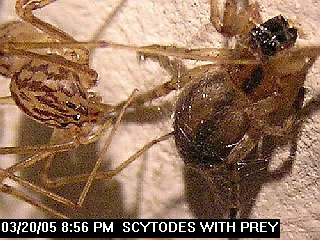
SSNARED!
The
spider was lying still in a corner, about 4 feet up the wall. I
took a
few pictures, and left the spider there. It was in the same spot
the next
morning, although it was positioned
differently. For all I know, it could
have run every corner in the apartment and returned. It was
*still* there
the next evening--and that's when things got interesting. I found
another
spider scurrying across my floor. I caught it, and tried to take
some macro
photos (it was pretty small) so I could identify it. Having done
that (I
found out later that my lighting
malfunctioned.), I wondered what would
happen if I put the new spider on the wall near the
Scytodes. Bear
with me--this was really interesting.
I quickly
set up my tripod and my C-770 ( I thought macros would be much
better than
my video camera. I only have one tripod, so had to choose.) I
rigged a
small flashlight as
a spot on the Scytodes. With everything set up, I placed
the "new" spider on the wall, and watched with my finger on the
camera
button. Today's RICKUBISCAM shot shows the
outcome. The newcomer
is snared and covered by a net of threads. The Spitting Spider is
cleaning
one of its legs. That image was one of the few stills that I shot.
Below
is a
sequence of frames from the video clip I shot of the attack.
Because
I was in "super macro" mode, depth of focus is very shallow, so
the spider
moved out of focus from time to time.
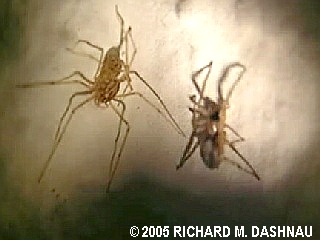 -
-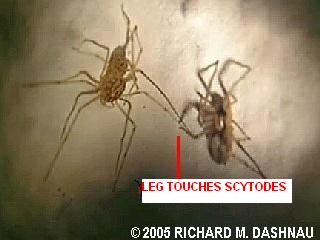 -
-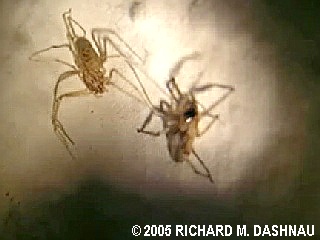 -
-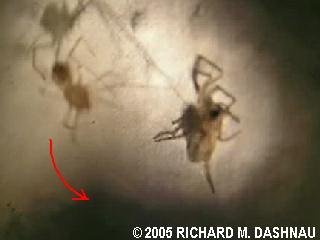 -
-
PREY
MOVES UP ON RIGHT
PREY'S LEG TOUCHES
SCTYTODES FACES PREY
SYTODES LEAPS SIDEWAYS

SCYTODES BEGINS SWING
The
unknown spider moved up past the scytodes, until one of its legs
brushed
the scytodes' leg. The scytodes turned towards the spider, and
leapt sideways
(although this could
have just been falling). It swung in an arc (with
its fangs facing the center of the arc) until it landed under the
unknown
spider. Then it slowly moved back up towards the unknown
spider. During
this time, the prey became ensnared, but still struggled. It
seemed to
me that the scytodes used its "spit" to swing on.
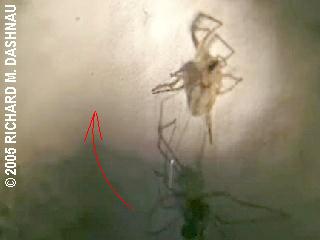 -
-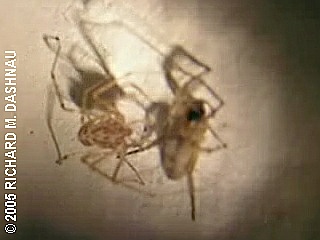 -
-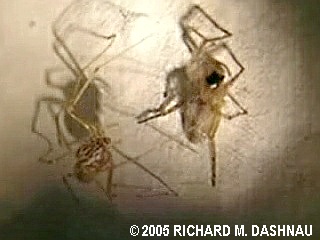 -
-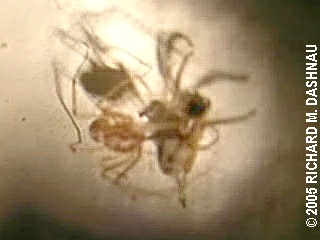 -
-
SCYTODES
LANDS BELOW
SCYTODES
COMES UP
REARS BACK-MORE SPRAY?
MOVES
FORWARD
AGAIN

FANGS TO THE ABDOMEN!
The
scytodes slowly moved towards the prey, and then reared back with
its forelegs
moving quickly. Perhaps there were more strands being deposited at
this
time. Finally, as the
prey struggled, I can clearly see the scytodes administer
a bite to the prey's abdomen! I can even make out tiny bumps when
the scytodes
withdraws after the bite. Immediately
after the bite, the prey stopped
moving, and the scytodes casually cleaned its forelegs. The
two images
below (CLEAN FIRST; READYTO EAT) are two more crops from
still
photos I
shot. This was...VERY cool!
----------------------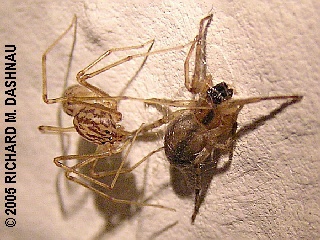 ------------------------------------------------------------------
------------------------------------------------------------------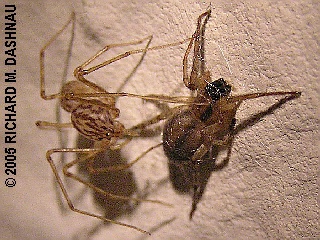
CLEAN
FIRST
READY
TO EAT
Now,
if you've seen my previous information about the scytodes (see
below),
then you might have seen my references to the work done by
professor R.B.
Suter, of Vassar University;
and perhaps gone to see his amazing high-speed
video clips of the scytodes' spitting patterns. Most of the
literature
that I've been able to find on the scytodes indicates that there
is
some
kind of "venom/glue" mixture being expelled by the spider.
Professor
Suter's research shows so far that the "spit" is a combination of
"silk
and a viscous liquid". He has work
in process which will detail some of
this research, and which I hope I will be able to see after it's
published.
There may be no evidence of "venom" as an active ingredient in the
liquid
snare. Thanks again to Professor Suter for taking the time to
converse
with me about this. What I've been able to capture in this
short
film clip may also show this. The scytodes' bite
seemed to be what actually
stopped the prey from moving--or killed it. I thought it was also
interesting
how the scytodes didn't swing with its abdomen at the center of
the arc--as
most
spiders would--but with its head facing the center. This
is
perhaps further proof for the silk properties of the spit, with
the spider
using it as a tether.
If you'd
like to see the video clips yourself, here are links to three flv
video
versions:
Normal
Speed--
392kb; slow
motion
part 1-- 707kb ; slow
motion
part 2-- 343kb.
And here are two larger wmv videos (encoded 5/17/12) of the same: Normal
Speed--
4.0mb ; "slow
motion"--
3.4mb
The
spider remained to feed on its catch for another day. Then, it was
gone.
What a lucky shot for me, though!
February
20 and March 08 2005
The image below (SIX EYES) shows 3 sets of double eyes on the face
of a
spider. The double eyes are also called "diads". This arrangement
of 6
eyes can help identify a few spiders. One of the spiders with a
similar
arrangement is the somewhat hazardous Brown Recluse, loxosceles
reclusa
. However,
my subject is NOT one
of those.
I have
had these spiders turn up from time to time in my bathroom.
-------------------------------------------------------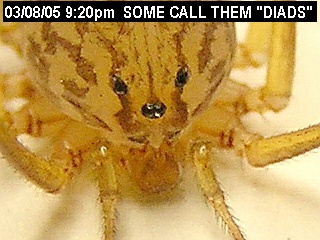
SIX
EYES
When
I identified my first one (in October of 2002) I was relieved, and
excited.
My occasional visitors are Spitting Spiders! (scytodes
species)
The Spitting Spider earns its name from
its specialized method of catching
prey. When it detects a potential live meal, the Scytodes slowly
moves
towards it until it gets within range (1-2 cm. according to
Biology
of Spiders, by
R. Foelix); and then it sprays two streams of a glue/venom
mixture from adapted openings at the base of its short fangs. This
is sprayed
in a zig-zag pattern over its prey, snaring it and
holding it fast. The
spider is then able to attack the immobilized prey with its short
fangs.
On Feb.
20, I found a Spitting Spider looking down at me from a corner of
my shower.
I captured it, and took a few pictures. These spiders, when caught
in the
light, usually don't move.
Once this one decided it wanted to move, it
moved quickly! I had a really hard time focussing the camera on it
as it
kept running up my arm (see ON RICK'S WRIST, below). You can
see
by comparison with some of my wrist hairs that the spider isn't
very big.
I was
finally able to convince it to climb onto the wall, and got
another photo
against the molding (see TOP VIEW, below). I also took a short video
clip (flv video 408 kb)
(wmv video encoded 5/17/12 3.1mb) (also see the frame from the
clip WALL WALKING,
below). Notice how it moves, sensing with its long
forelegs.
Note the short round abdomen, and
the mottled coloration. This is NOT a
Brown Recluse. I let the spider wander off while I went back
to my
business.
--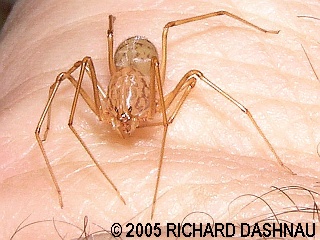 -------
-------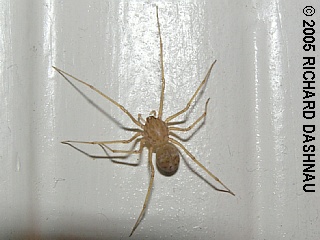 -------
-------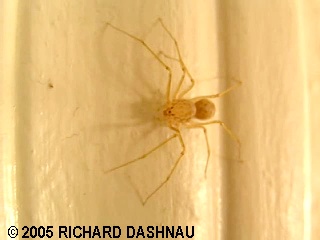 -------
-------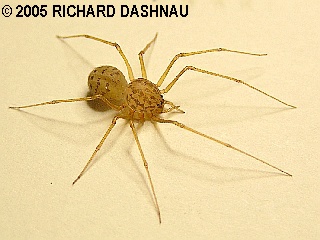
ON RICK'S
WRIST
TOP
VIEW
WALL
WALKING
OBLIQUE VIEW
video
clip
(flv video 408 kb)
(wmv
video encoded 5/17/12 3.1mb)
A few
days later, I was moving some pants in my closet, when I was
surprised
when a spider appeared from a folded pair of blue jeans and
started running.
I rotated the jeans as the spider
ran, watching it long enough to identify
it as another (or maybe the same?) Spitting Spider. I carefully
folded
the jeans back to the way they had been, and the spider found its
way back
into
a large fold, and I put the jeans back into the closet. On March
8th,
I decided I didn't have enough good pictures of the scytodes,
so
I took a chance and moved my jeans again. The spider
popped out, and I
captured it. I left it in the refrigerator for a little while, and
was
then able to photograph the spider while it warmed up. Now taking
a closer
look (see OBLIQUE VIEW, above)
we can take better note of the mottled coloration
on the spider. Another obvious identification characteristic
becomes evident
when we see the spider from the side (see SIDE VIEW, below).
The
carapace (top shell) is extremely humped (see HUMPBACK, below).
This is
unlike other spiders', and should easily identify the Spitting
Spider.
This spider's poison glands have
developed into large, two-lobed organs.
The rear lobe produces the "glue" and the front lobe produces the
venom.
The large humped cephalothorax allows enough space for these
structures
to fit. After the spider warmed enough to begin moving more
rapidly,
I put it back into my closet. I assume that it's still in there,
somewhere.
--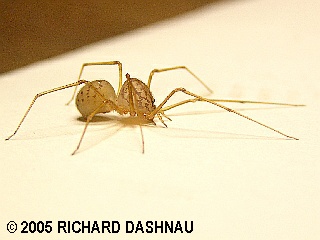 -------
-------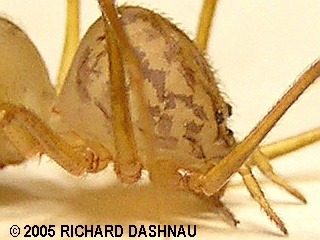 -------
-------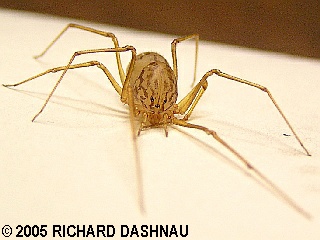 -------
-------
SIDE
VIEW
HUMPBACK
VIEW
FROM THE FRONT
The
scytodes are nocturnal, so most of us probably wouldn't normally
get to
see them hunting. It would also normally be difficult to get a
close look
at the glue spraying technique as well. However,
this event has been filmed
in close-up at high speed by R.B. Suter, of Vassar College. The
stream
of material is evidently redirected by manipulation of the fangs,
because
the streams move
rapidly from side-to-side while fangs can be seen moving
independently of the chelicerae. The glue is expelled by a large
tapered
groove which begins at the base of each fang and extends
about 2 thirds
of the way up. This is quite different from the structure of the
fangs
on most spiders, which more closely resemble a hypodermic
needle--that
is, with a smaller venom opening near
the tip. Thanks to Professor Suter
for providing this information.
In another
clip, again by R.B. Suter, the glue shows evidence of elastic
properties
after it's been expelled. The crisscrossing strands of expelled
adhesive
contract enough to move inanimate
objects (small wires) closer together.
Professor Suter has been generous enough to communicate a few
times with
me about his clips, and has been very informative. Thank you,
Professor
Suter! Follow this link to Professor
R.
B. Suter's page showing these clips (and one other, showing
the
lacelike pattern of the glue strands). They are amazing!
Meanwhile,
I'll be going to sleep tonight, wondering at the creatures hunting
in my
home.
If you'd like to know
more about the park follow these links:
Brazos
Bend
State Park The main
page.
Brazos
Bend
State Park Volunteer's Page The
volunteer's
main page.
Go
back to my home page, Welcome
to rickubis.com
Go
back
to the RICKUBISCAM
page.
Go
back
to the See the
World
page.

 -
- -
- -
- -
-















